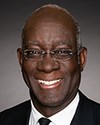Thank you so much, Chair.
I thank all the witnesses for being here. I deeply appreciate the information you've shared with us so far.
I'm going to come to you, Helmets to Hardhats. I will leave you to decide who answers, because you know what you do the best.
One thing you mentioned in your introduction today is about having created a specific initiative for women and LGBTQ2+ veterans. I'm wondering if you could expand a little on what that looks like so we can better understand what framework you're moving forward with.



